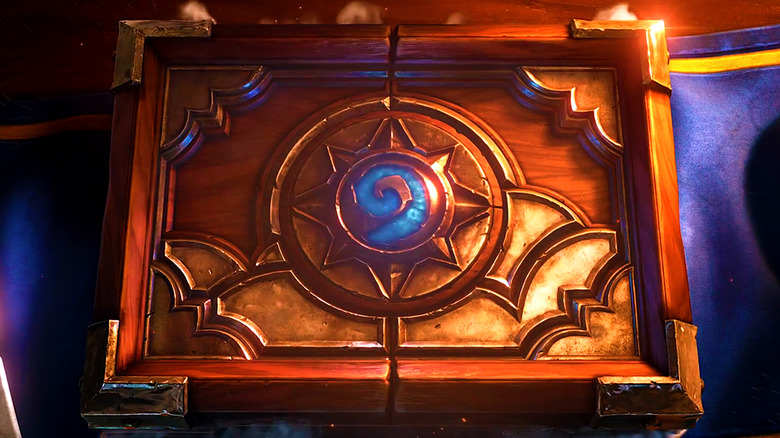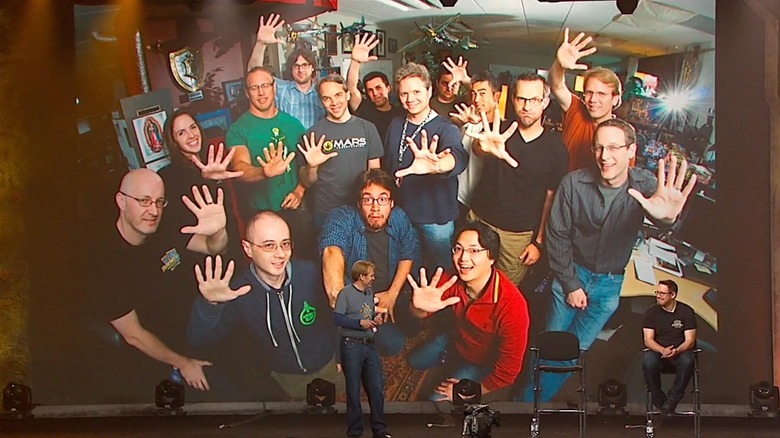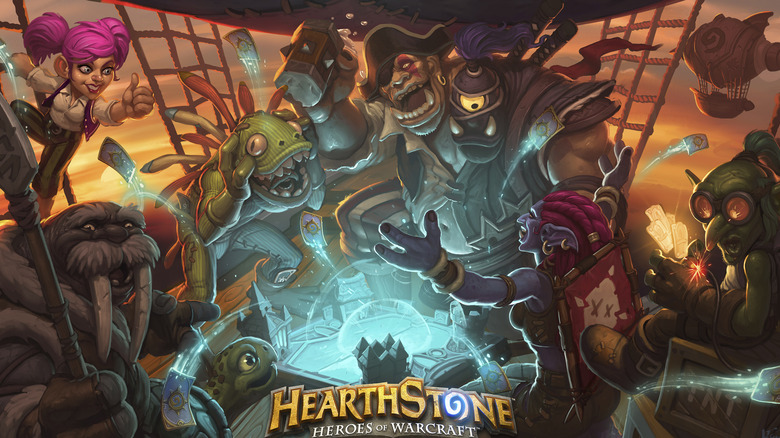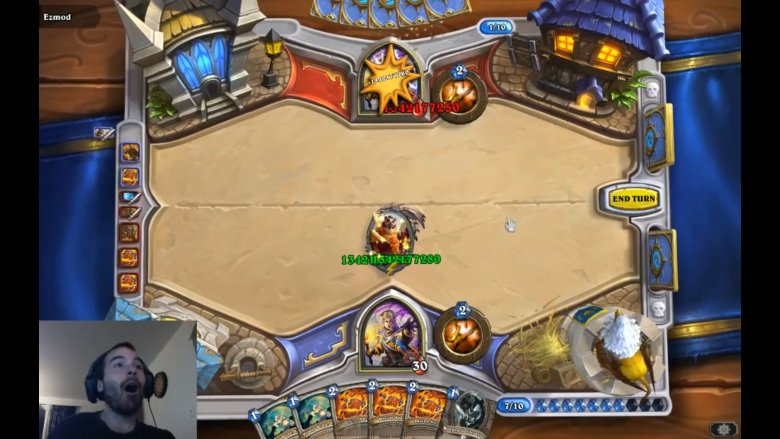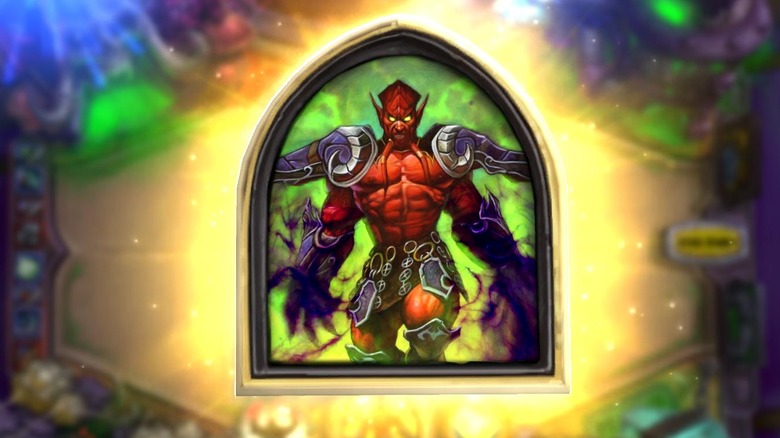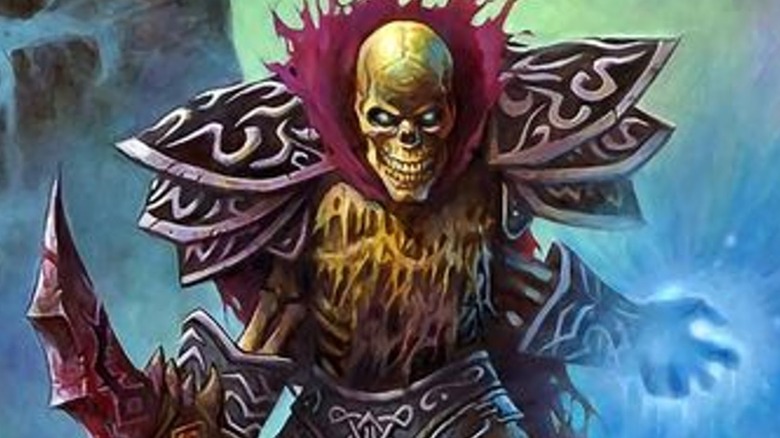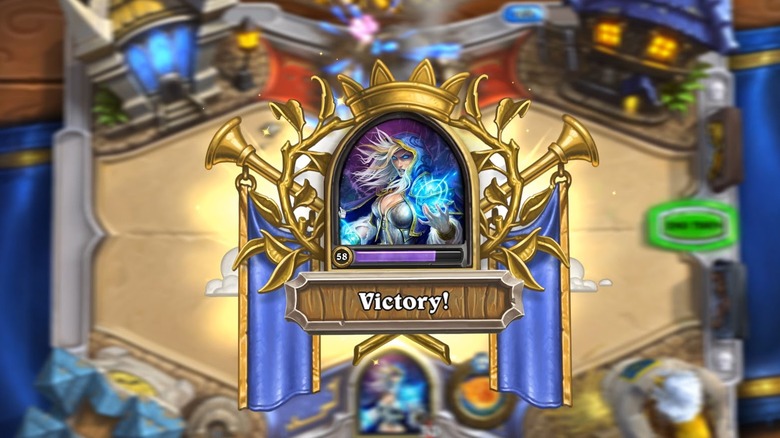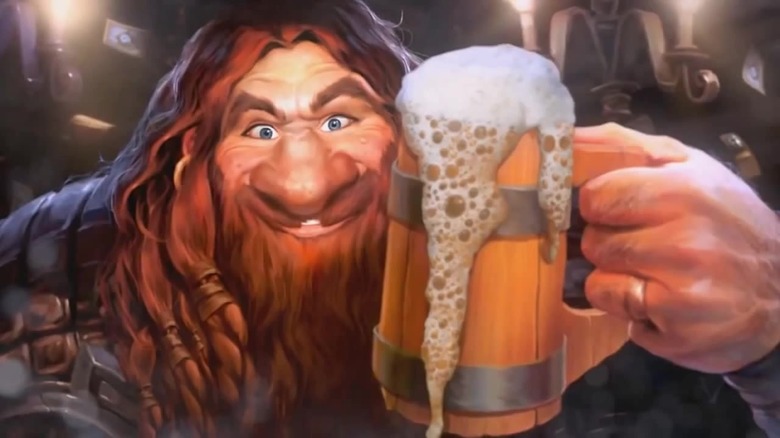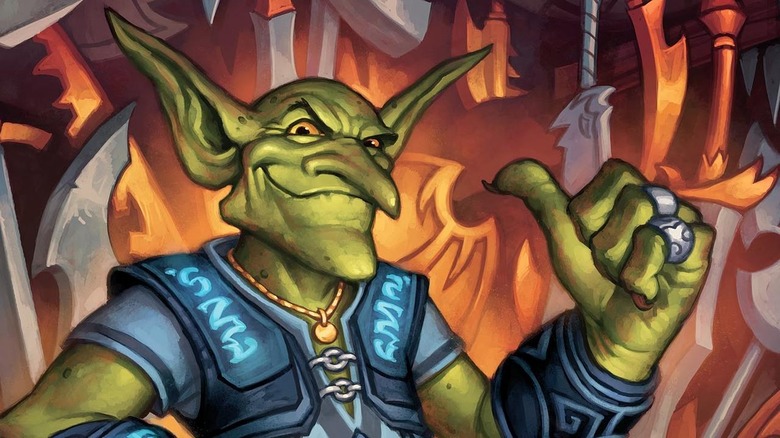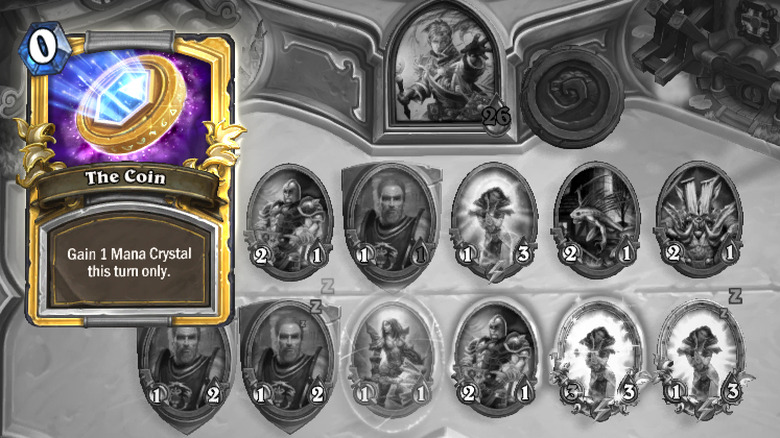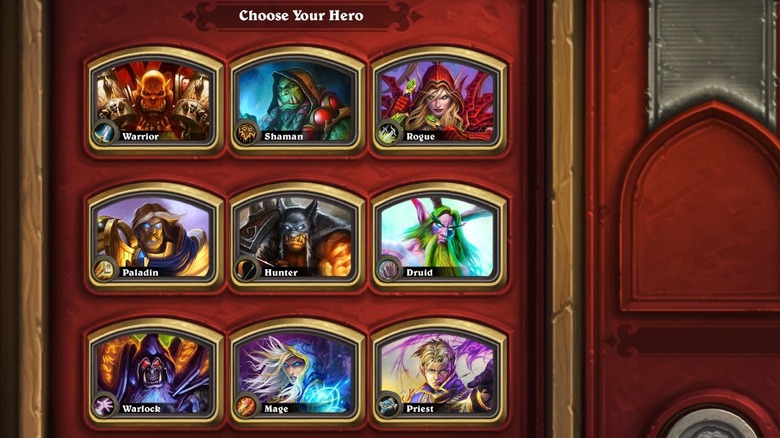False Facts About Hearthstone You Thought Were True
Hearthstone came out of nowhere to become one of the most popular games in the world. Developer Blizzard Entertainment had found success with RPG and RTS games previously, but Hearthstone represented a major departure for the company — one that would meet with almost immediate success. Hearthstone's beta took the world by storm and the game has only grown since then, setting the standard for online card game presentation while offering a different look at the competitive side of things, leaning into the random elements offered by an online-only platform to create a unique offering.
Because of its unique place in the market, there are a lot of misconceptions about how the game was developed and how it works to this day. Hearthstone's simplicity hides a lot of complicated concepts, so we've collected some of the most common false "facts" about Hearthstone to unearth the truth about one of the world's biggest and best games.
Hearthstone was designed like a traditional Blizzard game
When Hearthstone was being developed by Blizzard, the company had already released an incredible amount of successful games, including World of Warcraft and StarCraft. It would make sense, then, that Hearthstone would be designed using the tried and true tactics of a company that makes a habit of excellence in its intellectual properties.
In reality, though, Hearthstone's development was something of an anomaly in-studio. Blizzard had around 3,000 employees in 2008, when Hearthstone began its development. Yet the game was developed by a team that was only comprised of 15 people!
The small development team was named Team 5, and they were created specifically for Hearthstone. Blizzard's philosophy behind the team's creation was to do things differently than they had in the past, when the studio would employ 50+ person development teams that featured a lot of different specialized roles. Team 5, by contrast, was comprised of more old-school developers capable of wearing many different hats, and was tasked with creating a game that would be non-traditional for Blizzard.
Naturally, the success of Hearthstone has meant Team 5 needed to grow, with the team reaching over 70 members in 2017. While that team might be more in line with what we've come to expect from Blizzard, Hearthstone has its roots in some outside-the-box thinking from its publisher.
Hearthstone is a Warcraft spin-off
Hearthstone's name was originally a little bit longer: at launch, the game was known as Hearthstone: Heroes of Warcraft. That's likely because it was a brand new title and Blizzard wanted to associate the game with a property people already knew and loved.
That original name has caused a lot of people to think Hearthstone is a Warcraft spin-off title, however, and while there are innumerable ties that bind the two properties together, Hearthstone has evolved so much that it's difficult to think of it as a proper descendant now.
For one, the game has now dropped its Heroes of Warcraft subtitle, a branding move that has seen it become a standalone property that doesn't require familiarity with Warcraft lore to be enjoyed. The game has also begun to distance itself from Warcraft lore by exploring a multitude of different timelines; where the game once followed the events of Warcraft 3 and World of Warcraft very closely, in recent expansions heroes like Jaina and Thrall were made into Death Knights simply because it was a fascinating mechanic that every class needed access to.
Even in development, Hearthstone had other inspirations beyond Warcraft. A lot of Team 5 was required to move over to StarCraft 2 development for a year, and they came back with an appreciation for asymmetrical class balancing, something that has become a fundamental element of Hearthstone design.
Minion stats have no cap
Hearthstone minions have a habit of getting buffed pretty hard in competitive play. Barring a few formats that were heavier on silence effects, there have been a number of different combo decks that revolve around making one giant minion capable of ending the game in one brutal attack. Priest is usually the chief offender for these kinds of decks, thanks to Divine Spirit and Inner Fire, the former doubling minions' health while the latter changes their attack to match that newly inflated health total.
Most combos don't really approach truly mind-boggling stats, so it's reasonable to assume that there isn't a cap. Some people who wanted to test the far reaches of Hearthstone's game engine discovered otherwise, however, and have since posted videos revealing the existence of a health limit cap.
According to the video, the maximum health of a Hearthstone minion is exactly 2,147,483,647. The numbers actually start to run off the card in a comical fashion at that point, as it isn't something the designers have really had to worry about over the game's history.
Once someone attempts to set a minion's health above that maximum total, the minion's health resets to zero, destroying it in the process. It's a neat little bit of Hearthstone lore that is totally irrelevant to gameplay, since setting up the process involves a lot of cooperation from the opponent. Good luck ever setting it up, but the minion health cap is real!
Heroes can't be destroyed outside of reducing their health to zero
Anyone familiar with Hearthstone probably feels like this one is pretty obvious. The way to win a game is to reduce an opponent's hero to zero health. Even when using alternate methods like destroying an opponent's deck so they no longer have any cards to draw, the ultimate win condition is still health reduction, as heroes take damage that increases by one each turn they can't draw a card from their deck.
In practice, however, there's a corner case way of defeating an opponent that doesn't require dropping their health to zero. What it does require is the Lord Jaraxxus card, a legendary Warlock-only minion whose battlecry changes the Warlock hero into Jaraxxus himself. If you've only recently started playing Hearthstone, the card might be unfamiliar as it has fallen out of favor in place of the Guldan Death Knight, but Jaraxxus was once the almighty win condition of the control Warlock deck.
The thing is, Jaraxxus is a demon, and he retains that mechanic even when he becomes a player's hero. The Warlock card Sacrificial Pact reads "destroy a demon." The results are pretty funny.
Sacrificial Pact doesn't see much play, but it was a tech card for Warlock mirrors back in the day. If nothing else, the Sacrificial Pact hero kill is just another example of the depth present in Hearthstone's game design, which favors fun, niche interactions over restrictive gameplay rules.
Hearthstone's card art is all originally designed for the game
Here's another one that at first glance seems like it should be true. Hearthstone is made by Blizzard, one of the biggest game developers in the world, and can certainly afford to have an in-house art team design all of the card illustrations for the game.
In actuality, though, Blizzard was a lot more savvy with their existing art when it came to bringing Hearthstone cards to life. World of Warcraft once had a pretty good trading card game of its own, a competitive cardboard-only offering that had a devout following of fans. Unfortunately, the game eventually slowed down to the point it had to be killed off, but a side benefit of its existence was the fact it had produced a lot of Warcraft-themed artwork.
Instead of letting that artwork go to waste, Blizzard repurposed it for Hearthstone, especially the game's first few sets. Players can see it in cards like Bloodmage Thalnos, a character who exists in Warcraft lore but whose art actually depicts an entity known as Turov the Risen, an entirely different character who had a WoW TCG card. Another example is the Hearthstone card Mal'Ganis, whose art depicts another Dreadlord named Varimathras.
One of the most appealing things about Hearthstone is the game's card art, though, so if the WoW TCG had to die so that Hearthstone could have gorgeous illustrations, that's a trade we're willing to make.
The amount of XP awarded at the end of a game is fixed based on a win or a loss
At first glance, Hearthstone's ladder XP system seems to be pretty straightforward. When you win, the XP bar moves further along than when you lose. Hearthstone isn't as mechanically complex a game as something like Dota 2, so while ELO and other metrics make sense for those sorts of games, having Hearthstone award XP based on wins and losses makes sense.
Except that's not exactly how it works. Hearthstone actually uses an XP system that considers multiple factors when calculating how much experience a given player will get for the game they just played. Beyond just wins and losses, Hearthstone actually rewards players for number of cards played and minions destroyed as well. The exact metrics aren't specified, but those qualities exist within the system.
It's actually interesting to note that if XP weren't mostly superfluous — it rewards golden Basic cards at its highest levels so far — there would be ways to game the XP gain system to get rewards faster. Decks like Freeze Mage often focus on destroying enemy threats before finally executing their win condition. A deck like that would earn more XP than something like Face Hunter, which ignores enemy minions and card draw effects and aims to end the game as quickly as possible.
Naturally, the best thing to do is simply keep winning. If only it were always that simple in Hearthstone.
Hearthstone has always taken place within the Inn
One of the most welcoming things about Hearthstone has been the presence of its Inn. The Inn is where players log in to decide how they want to play the game, and features a nice aesthetic complimented by a friendly dwarf Innkeeper who always has something cheery to say when players boot up Hearthstone.
Weirdly enough, however, Hearthstone wasn't always intended to take place within an inn filled with adventurers. Originally, Hearthstone included a world map that players could explore, featuring various landmarks and locations familiar to those who follow Warcraft lore. Players could also accept quests within that map, making the original Hearthstone design much more close to how World of Warcraft is set up.
Luckily for all involved, that design changed as the team explored more possibilities. It would have been much harder to separate Hearthstone from its Heroes of Warcraft subtitle had the game revolved around a map of Azeroth, and the Inn aesthetic has become a staple of Hearthstone LAN tournaments. It's hard to imagine a Hearthstone world without the Innkeeper and the flickering candlelight of his establishment, but it's one that we almost lived in.
Hearthstone's deck names come from the cards that are played in them
A popular naming convention in card games is to refer to a deck by the way it plays or a key card within it. In Hearthstone currently, there is Togwaggle Druid and Malygos Druid, decks that are built around one specific card as a kill condition and are named after them. It follows that most decks in Hearthstone would be named after the cards in them, then.
Weirdly enough, a lot of Hearthstone's broader terminology for decks actually comes from Magic: The Gathering. Zoo Warlock, a deck that has existed through multiple Standard formats, is named after the Zoo archetype in Magic. Both decks feature similar theories of putting small, over-powered minions onto the battlefield and then dictating the pace of the game with them, so the naming convention makes sense.
Miracle Rogue, on the other hand, is a big stretch. Miracles is a deck in Magic that operates quite a bit differently from the Rogue deck in Hearthstone, so it's unclear why the deck was called Miracle Rogue in the first place. The name stuck, though, and it's one of the most recognizable terms in the Hearthstone lexicon.
You can never own a Golden Coin
There's a saying among new players who are a little jealous of a veteran's blinged out, golden-bordered Hearthstone deck: that you can never have a Golden Coin, so the deck can't be entirely golden. Basically, The Coin is a card awarded to players from outside their deck, and thus can't be made golden. As such, many newer players believe there is no such thing as a Golden Coin.
That's not actually true, however. Golden Coins can be made in a number of different ways in Hearthstone, and it's satisfying every single time. The original method involved using a golden version of the Priest card Mind Vision, which, when it copies a card, turns the copy golden as well. Since that interaction, however, Hearthstone has released several cards that produce coins as part of their abilities, and if those cards are golden, the coins will also be sufficiently shiny.
Sure, you never actually own the Golden Coin for longer than a game, but it's a step forward in the right direction for those players who simply have to have the shiniest cards possible in whatever deck they build. We'll just settle for enough dust to craft the next hot Legendary card, though.
Hearthstone is game-first, lore-second
One of Blizzard's core corporate tenets is "Gameplay First." Because of that, you might think that Hearthstone is a game explicitly designed around its innovative mechanics, with lore tie-ins as a secondary consideration.
In practice, that couldn't be further from the truth. Despite Hearthstone's lore being something that players need to dig into a little to really find, the game is designed with lore in mind at nearly all turns. The Team 5 design philosophy states that heroes have to reflect their World of Warcraft inspirations as closely as possible.
What that means is that Hearthstone's game mechanics are very restricted by the way the team can tie them in to each hero. A paladin having a card that sacrifices a minion for the hero's gain would not make sense from a lore perspective, and so it is unlikely the class ever receives such a card.
Essentially, the design restrictions on Hearthstone make it a game that balances gameplay and lore equally. From the way it's impacted the diversity of the game, including how heroes feel so different mechanically, that's been a very good thing.

